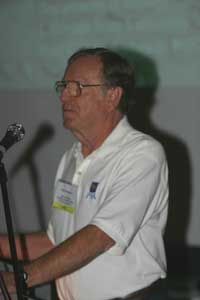Golden Alga (Prymnesium parvum) in Texas
Workshop Abstracts
Prymnesium parvum
Laboratory Studies: Structure, Reproduction,
Salinity Tolerance and Bioassay
 Paul
Kugrens
Paul
Kugrens
Department of Biology, Colorado State University, Fort Collins, Colorado, 80523 USA
Abstract.--Three isolates of Prymnesium parvum from different geographic localities were studied with respect to their structure, cyst formation, mixotrophy, and range of salinity tolerances. Two isolates were obtained from the UTEX culture collection, which included an isolate from Texas and a European strain from Plymouth, England, and the third was isolated from a high plains lake in Wyoming. All strains have a similar cytology and cell morphology, although cell shapes varied somewhat among the strains and within cultures and in different salinities. Cells are biflagellate, they have a non-locomotory organelle between the flagella called the haptonema, they are covered with small, oval, ornate organic scales, they contain two to four chloroplasts with pyrenoids, and they have a large posterior vacuole that contains the storage product chrysolaminarin. Light and electron microscopic observations did not reveal mixotrophy, which was based on observations of thousands of cells. Cultured Prymnesium reproduced exclusively by asexual reproduction through cell division, and sexual reproduction was not observed. Induction of cyst formation was attempted; however, cyst formation was never observed in any treatments, which included nutrient depletion, elevated or lowered temperatures, desiccation, growth in the dark, and aged cultures, some of which were 6-12 months old. Several media were used in this study to determine the ability of Prymnesium to grow in different types of water. One medium consisted of seawater based medium, another was an artificial sea water medium, and a third used water from highly alkaline lakes from Wyoming. All strains grew equally well in all seawater media and in the high alkaline water medium from Wyoming lakes, although the marine strain had the lowest growth rates in all of these media. The Wyoming and Texas strains grew well in all salt concentrations tested, whereas the marine strain’s growth correlated with the salt concentrations, specifically it exhibited corresponding reduced growth in decreased salinities. A simple canine blood bioassay technique for testing toxicity was used for the hemolytic toxin produced by Prymnesium. The bioassay consisted of centrifuged and lysed Prymnesium cells, and the lysate was resuspended in a saline buffer solution. Heparinized canine red blood cells were added to the buffered saline solution that contained the lysate, mixed and examined microscopically. All Prymnesium isolates caused 100% hemolysis within one minute, whereas all red blood cells remained intact in parallel control experiments that utilized the related prymnesiophytes Chrysochromulina parva and Diacronema vlkinanum. Since Prymnesium grows best at higher pHs, a possible mechanism for its rapid growth is proposed and is based on the specific membrane arrangement in golden algae cells, which might involve the ability to acquire dissolved inorganic carbon (DIC) in the form of carbon dioxide that would be limiting in high pH waters. Possible biocontrol, using protists belonging to Kathablepharis, and the efficacy of using this genus will be presented. Finally, the massive fish kill that occurred in Colorado in May 2002, which was attributed to Prymnesium, will be discussed.
Download
presentation  (PDF 7.2 MB). If
you are unable to access this document, please contact
us for an alternative format.
(PDF 7.2 MB). If
you are unable to access this document, please contact
us for an alternative format.